life in a (former) one-frog town
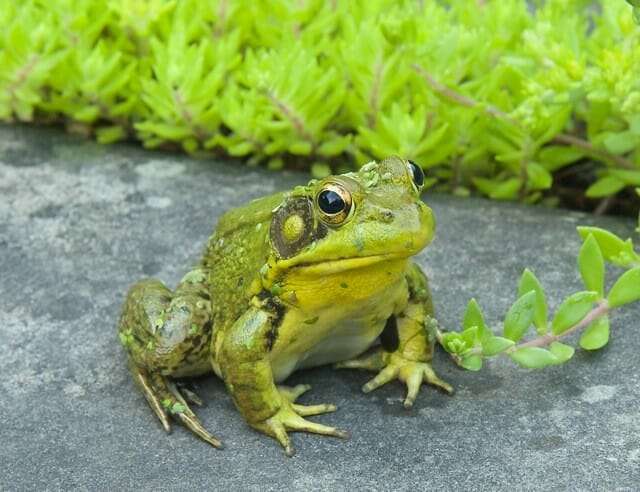 INHOSPITABLE. That’s the word my friend out back and I have both been using to describe the mostly rainless weather lately (and we’re invoking some uglier words, too).
INHOSPITABLE. That’s the word my friend out back and I have both been using to describe the mostly rainless weather lately (and we’re invoking some uglier words, too).
“There wasn’t one proper Big Night,” he said one morning last week at poolside over breakfast—mine the over-medium with goat cheddar on buttered whole-grain toast; his something indistinguishable but still wriggling when swallowed.
Big Nights are those thrilling first rainy nights when winter lets go, when the temperature reaches at least 40°F and the ground is thawed, a trigger for certain amphibians to emerge en masse from their wintering sites in search of breeding grounds. Like temporary vernal pools—or my backyard water gardens.
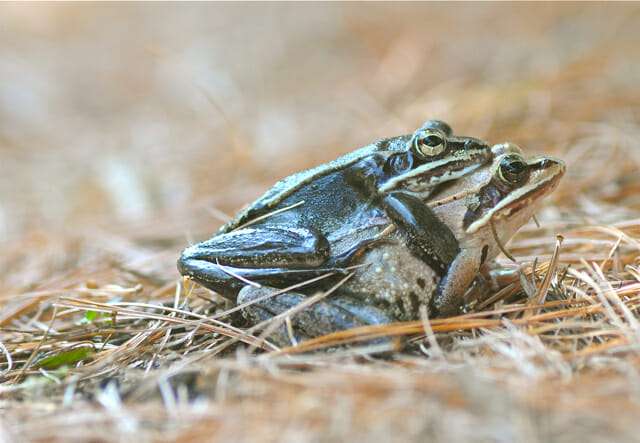
One wet 40-degree-plus night all spring, and barely that–a real hardship for our amphibian friends. Wood frogs, the cold-hardiest of frogs (above, in the mating embrace called amplexus) and spotted salamanders (below) might have found it good traveling weather, but not you, my friend.
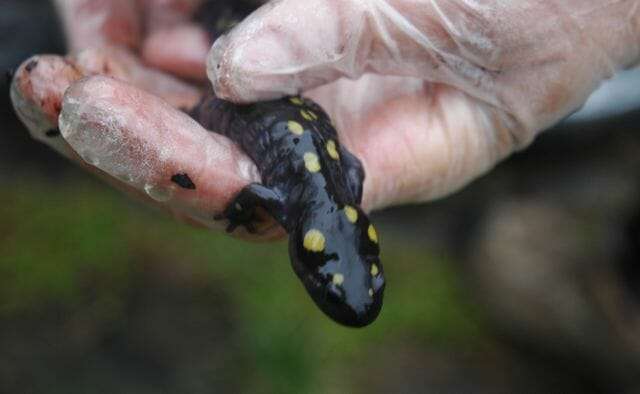
THAT EVENING, I heard the rain while I was watching “The Wire” (yes, the whole thing, over again, all these years later). And then, punctuating the rain’s rhythm: the voice of a peeper—the first in about a month here in the yard with its two little artificial garden pools, where in a normal spring, when there is regular rain, I always have a couple singing nightly.
Would my green-frog friend have company by morning, I wondered for a moment, then went back to grittier matters involving not amphibian mating rituals, but sawed-off shotguns, in matchups between Omar and the Barksdale crew.
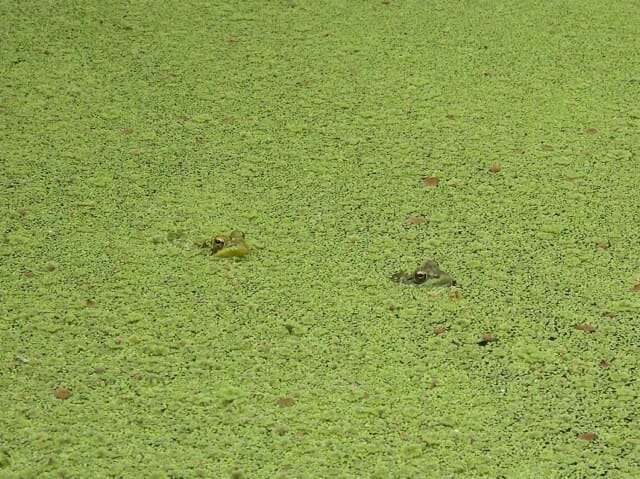
Boy or girl, though? Who had arrived? To be sure, I’d have to see her tympanum, the ear drum-like structures frogs hear with, or the color of her chest. (Read how to tell what sex a frog is.)
I knelt, slid my hand gently beneath her, and lifted her from the water.
A girl—and so full of eggs, she filled my palm with her girth.
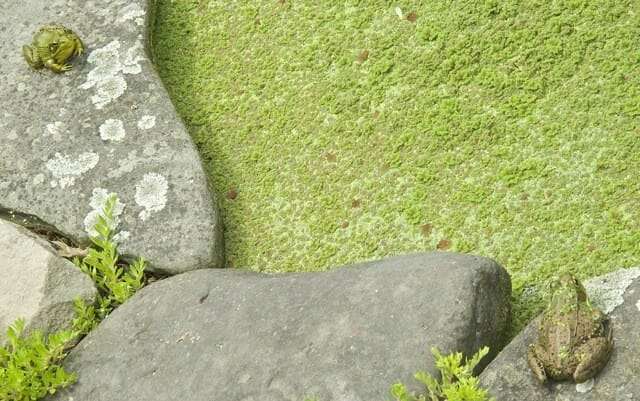
In the morning, no female frog to be found, but in her wake: a glistening glob of spawn (below).
Let there be tadpoles?
why vernal pools?
EVER WONDER why amphibians would seek out a temporary water feature like a vernal pool to mate and reproduce in? The answer should be obvious—but wasn’t to me. I guess I’d never thought it through. Temporary seasonal water bodies are not a place where fish can live. And what do fish eat? Well, amphibian eggs (and in some cases tadpoles and adults), among other things. Apparently the survival instinct to find a fishless mating ground is just one more stunning example of the genius of nature.


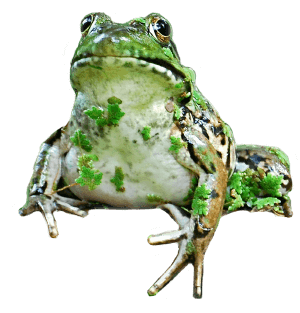
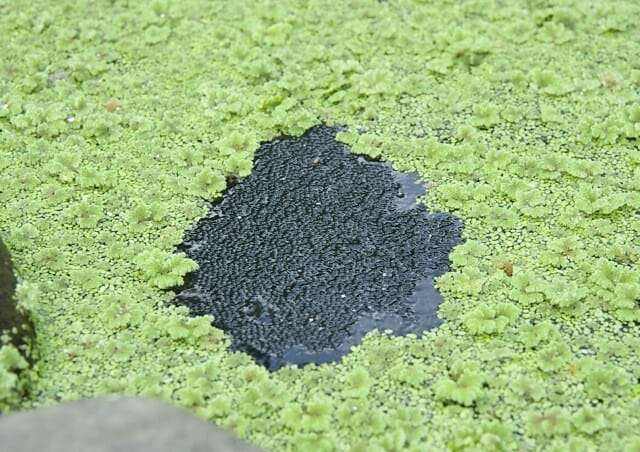


We were at our house in the Berkshires last week, and the peepers were making their racket down by the lake…our 18 year old son thought all these years they were birds, and was astonished to learn he’d been hearing frogs this whole time!
That’s it – I am scheduling a date on my calendar to dig a small pond! This is fascinating and I just love it. I want to hear those peeps and croaks. Give the man a cigar! I considered adding mosquito fish to my small pond – hinder frogs? I really want the frogs!
We have had as many as 6 mating frogs in our pond at once and the sound can be deafening. My grumpy husband has been known to relocate them to the stream at the back end of our property only to have them return the next night. I find it humorous.
Wonderful piece! I have a small pot with a dwarf water lily in it. Said water lily perished in our brutal February, so I put a papyrus I brought out from the house. Almost overnight there were eggs floating and now tiny tadpoles. I have 2 questions: 1- do tadpoles eat mosquito larvae? Because normally I let the water run over to clear them but now fear the little tadpoles would go overboard at the same time, and 2- how in the world did the frogs make it into this high pot – almost 2 1/2-3 feet high? They can’t jump that high can they? Thanks!! Karen
No , tadpoles only eat algae and greenery….when I raised them as a kid, I fed them iceberg lettuce of all things! They, unfortunately, don’t eat mosquito larvae.
I always wondered why frogs mated in my dog’s water bowl. I guess they consider it a “vernal pool”. Unfortunately, I’m the neat, tidy type who empties the bowl daily and washes it down. Perhaps I should empty it into my very small pond when I catch them in the act.
Good idea, JJ. Into the small pond its contents should go if there are any eggs. Hilarious that they use even such a small volume of water.
I have learned so much from reading your blog, and found so many books and plants and nurseries! But I must comment on the first picture, which is beautiful. All the greens in the frog and the sedum, with the gray stone anchoring it, really a lovely photo. A really nice shot. I have always enjoyed the pictures but this one really stands out.
What an enchanting piece! I am very fond of frogs. Once after a big rain storm I found three little tree frogs in my living room. They had gotten in under a gap in my screen door. They are so sweet! I put them safely outside again, though I wished I could keep them. Your frogs pictures are indeed beautiful. Love the comment about the dog bowl. I didn’t know the reason behind vernal pools until this article. Knowing makes me feel closer to all the mystery.
My husband is the “frog keeper” in our pond. (Sometimes I hear him down there chatting with them.) He was very worried that there were none for many weeks recently but finally we have a few — still not the usual population. Bad spring for frogs.
So far in my pond only toads. And now a bumper crops of tadpoles!
Margaret – how about The Wire??? Opinions range from “the best thing never seen on television” to plain ol’ the best television series ever. “Omar comin’!”
Sally, Baltimore
One tree frog and one toad so far. Thanks so much for the sex identification. Does that hold true for all species. Sadly I do not see either one this a.m. but we are under a flood watch here in Northern Indiana. There is about 5 inches of water in the wheelbarrow which was empty at 3 p.m. yesterday.
Last night the songs of the tree frogs were unbelievably loud. Around 10, I wandered out into the moonlight and found about a dozen of them around the edge of my swimming pool, singing their hearts out (and unafraid of me as I got close to look at them). There were countless others up in the trees feet, yards, and acres away. Magical!!
True that frogs and toads have been scarce this spring; but another odd thing happened last week.
I had to stop for a 15″ snapping turtle crossing the road near my daughter’s home. My concern for a safe crossing was not shared by the turtle (They do a real quick 180° and have you seen the length of their necks?). No help in getting it to the other side so I left nature be.
According to the natives and a Google Earth search, there is no pond or stream for over a mile. What kind of range do they have?
Hi, Gene. I haven’t seen a snapping turtle near me, but I do seem them on some other roads not far away, and you are right — sometimes not anywhere near water! I looked it up: “The nesting season [in New England] is from April through November, with most of the nesting in southern New England occurring in late May through June. Snapping turtles rarely leave their aquatic habitat except during the breeding season, at which time females travel great distances in search of a place to dig a nest and lay eggs. Some turtles have been found as far as a mile from the nearest water source. Selected nest sites include banks, lawns, gardens, road embankments, and sometimes muskrat burrows.” Bet you saw a female on the move! From Connecticut Dept. of Energy and Environmental Protection. More here.
Thanks for the info. I live just above the Cuyahoga Valley National Park and have seen them laying eggs along the banks of the Ohio-Erie Canal. Didn’t ever know the ladies might go to such lengths to nest.
Years ago, we knew some men who drove a van to Canada and only “fished” for snappers. They claimed they were taking them back to Cleveland, OH to sell to the downtown restaurants.
This was a lovely piece with charming images. I am on the lookout for a vintage container for my new frog pond. Thank you, Margaret!
Loved your frog article. I have been patiently waiting for frogs too, although I generally don’t see more than one at my small, raised, 3’x6′ pool. I have been blaming my cat. Also, my pool is totally shaded so the water stays quite cold, and have always thought that is why no mating is going on, either with the frogs or the small koi. But now you have cleared up the question of why it might be inhospitable to frog off spring. Thank you.
I live in northeast Ohio. The peepers started singing here on the 1st of April–about a week and a half later than usual. Through the snow and cold in January I cheated and listened to their sleigh bell singing on YouTube. Desperate times call for desperate measures.
These days my “garden” is all in pots. I live in a second floor apartment and still miss my garden of twenty years ago.
But I do have one advantage: The Cuyahoga Valley National Park is only a mile away. So each evening I walk the towpath and get my fill of frog music.
Thanks so much for your website. It’s a lifesaver!
Thanks for your kind words, Catherine. Nice that you have such good frog habitat nearby!
Fascinating reading about vernal ponds! Our house in the Hudson Valley, NY is surrounded by wetlands. Most years they stay wet. And the sound of many types of frogs is deafening, you go out on the deck and your ears start ringing from the tree frogs high pitch! The other morning I woke to the sound of laughing frogs. One would call out ruff-ruff-ruff to be answered by another doing the same call. Sometimes there’s a frog that sounds like a springing rubber band, “darrang”. Different voices from different species…
Last weekend we added nice soft topsoil to a too low flower bed at our northeast Ohio home. Three days later, I noticed, what I thought, was a large rock added to my bed. On closer look it turned out to be a large snapping turtle laying eggs! A creek runs behind our property so I shouldn’t have been surprised, but I certainly was. This is going to be an interesting spring to summer. Amazing how she knew there was fresh dirt.
Nice story, Lynn. Aren’t they amazing? Lucky you.
Beautiful article, Margaret…thank you! Down here in hot, humid Florida we have frogs like crazy. Our three rescued pot-belly pigs have kiddie wading pools to dip their surprisingly dainty tootsies in, and the frogs love these pools. Currently we have thousands of tadpoles. The pigs disturb them very little, and I suspect the tadpoles are delightfully tickly on the pigs’ skin when they wade. From now on I will call the pig pools ” the vernal pools”.
What a hilarious image, Jan, with the pigs and the tadpoles — not one of nature’s usual animal combinations!
My cat was the first to notice the baby frog on the kitchen floor. We have had a lot of rain but I can’t figure out how it got in the house!
I have brought them in on houseplants, of course, in the fall (when it’s time to bring the potted stuff back inside for the cold season). Out jumps a frog. Very funny. Maybe yours rode in on the cat. :)
It is so fun to hear of frog mating, etc. when it’s happening right before your eyes. I do have one little guy who apparently survives NE winters without the help of a pond and then appears out of nowhere to spend another summer in damp shady spots. I wish I had the knowledge to understand his take on survival. Oh, and we would have gladly shared some of our rain with you; virtual weeks here without seeing the sun was/is a morale bruiser.
I once ALMOST transported a frog into the house in the fall. Fortunately I put the pot on the steps to the conservatory to trim off some tattered foliage. I was very surprised when a frog jumped out, almost in my face (but very grateful that it left the pot before it moved inside!)
We were frog-less for a period this spring, but now we have three smallish frogs in our pond. I have learned to trust that nature will fill any gaps.
Thanks for your fascinating and informative posts about frogs and their habitat. I followed your lead and bought a 15-gallon tub and some azolla caroliniana and filled the tub with water. That was in late June, and for awhile things went well – the multiplied and was green and frogs showed up and mated, but then the azolla turned brown around the edges and one frog died. I found him floating in the water, without a mark. I wonder if I’m somehow creating a toxic environment? I still have two frogs, but sometimes they seem stressed, breathing heavily and floating listlessly. I don’t want to offer them a toxic soup. The tub I ordered came from a veterinary supply store and is a feed tub for horses, so it shouldn’t have any toxic ingredients. Twice I’ve seen tiny tadpoles in the “pond,” some just this morning. I’d love your thoughts on this – browning ferns and dying frogs – what am I doing wrong? I’m fairly near you, by the way, in the northwest corner of CT.
Hey Margaret! I have been following you for a few years and I love your pots of pondweed and water. I’m in Ontario – how do i set this up? where can i buy native pondweed? Do you recommend harvesting it from an area that is abundant? We have wicked droughts here in Prince Edward County….This seems to be ok for the grape growers, not so great for wildlife. thanks so much.
kelly
Hi, Kelly. Because you are in Canada, you’ll need to identify a water-garden nursery (online catalog probably) and search the category usually called “floating plants” to see what is offered Lemna minor (duckweed) usually is, and is native through a wide range in North America. I don’t recommend wild-harvesting anything. I order a supply each spring. Sorry I don’t know which Canadian catalog to recommend, but do a web search and see what looks most promising.